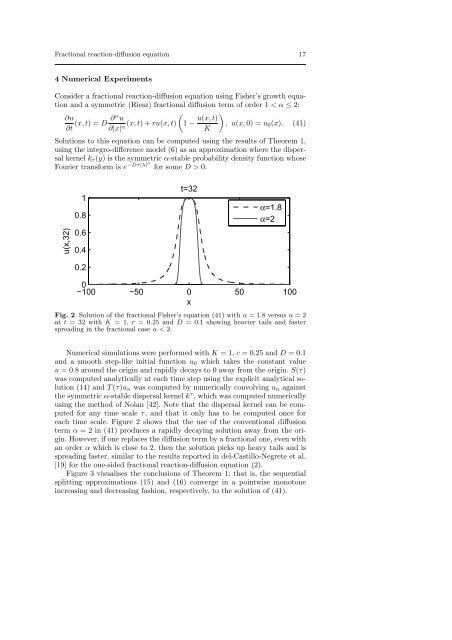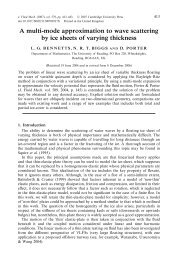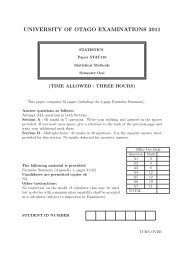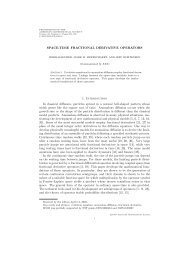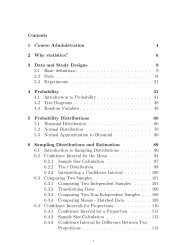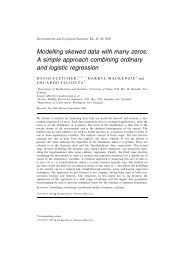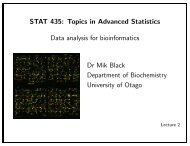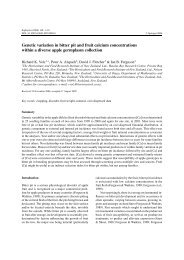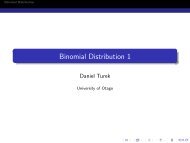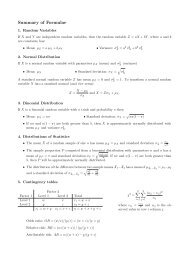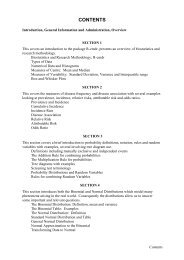Fractional reaction-diffusion equation for species ... - ResearchGate
Fractional reaction-diffusion equation for species ... - ResearchGate
Fractional reaction-diffusion equation for species ... - ResearchGate
Create successful ePaper yourself
Turn your PDF publications into a flip-book with our unique Google optimized e-Paper software.
<strong>Fractional</strong> <strong>reaction</strong>-<strong>diffusion</strong> <strong>equation</strong> 17<br />
4 Numerical Experiments<br />
Consider a fractional <strong>reaction</strong>-<strong>diffusion</strong> <strong>equation</strong> using Fisher’s growth <strong>equation</strong><br />
and a symmetric (Riesz) fractional <strong>diffusion</strong> term of order 1 < α ≤ 2:<br />
( )<br />
∂u<br />
∂t (x, t) = D ∂α u<br />
∂|x| α (x, t) + ru(x, t) u(x, t)<br />
1 − , u(x, 0) = u 0 (x). (41)<br />
K<br />
Solutions to this <strong>equation</strong> can be computed using the results of Theorem 1,<br />
using the integro-difference model (6) as an approximation where the dispersal<br />
kernel k τ (y) is the symmetric α-stable probability density function whose<br />
Fourier trans<strong>for</strong>m is e −Dτ|λ|α <strong>for</strong> some D > 0.<br />
u(x,32)<br />
1<br />
0.8<br />
0.6<br />
0.4<br />
0.2<br />
t=32<br />
α=1.8<br />
α=2<br />
0<br />
−100 −50 0 50 100<br />
x<br />
Fig. 2 Solution of the fractional Fisher’s <strong>equation</strong> (41) with α = 1.8 versus α = 2<br />
at t = 32 with K = 1, r = 0.25 and D = 0.1 showing heavier tails and faster<br />
spreading in the fractional case α < 2.<br />
Numerical simulations were per<strong>for</strong>med with K = 1, c = 0.25 and D = 0.1<br />
and a smooth step-like initial function u 0 which takes the constant value<br />
u = 0.8 around the origin and rapidly decays to 0 away from the origin. S(τ)<br />
was computed analytically at each time step using the explicit analytical solution<br />
(14) and T (τ)u n was computed by numerically convolving u n against<br />
the symmetric α-stable dispersal kernel k τ , which was computed numerically<br />
using the method of Nolan [42]. Note that the dispersal kernel can be computed<br />
<strong>for</strong> any time scale τ, and that it only has to be computed once <strong>for</strong><br />
each time scale. Figure 2 shows that the use of the conventional <strong>diffusion</strong><br />
term α = 2 in (41) produces a rapidly decaying solution away from the origin.<br />
However, if one replaces the <strong>diffusion</strong> term by a fractional one, even with<br />
an order α which is close to 2, then the solution picks up heavy tails and is<br />
spreading faster, similar to the results reported in del-Castillo-Negrete et al.<br />
[19] <strong>for</strong> the one-sided fractional <strong>reaction</strong>-<strong>diffusion</strong> <strong>equation</strong> (2).<br />
Figure 3 visualises the conclusions of Theorem 1; that is, the sequential<br />
splitting approximations (15) and (16) converge in a pointwise monotone<br />
increasing and decreasing fashion, respectively, to the solution of (41).


